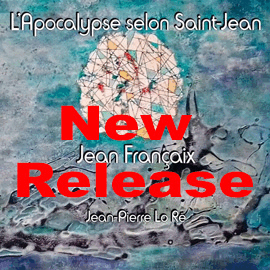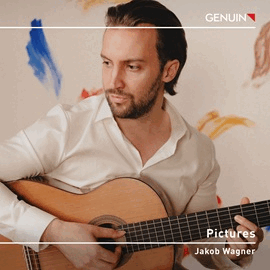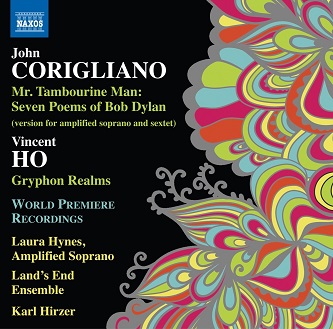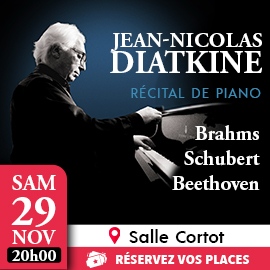John Corigliano hat im Zyklus Mr. Tambourine Man sieben Songtexte von Bob Dylan vertont. Corigliano sagt: « Mir ist kein Fall bekannt, in dem so etwas schon einmal gemacht wurde (das war einer der Gründe, warum es mich reizte), also musste ich erklären, dass es sich in keiner Weise um Arrangements, Variationen oder Ableitungen der Musik der ursprünglichen Lieder handeln würde, die ich nicht hören wollte, bevor der Zyklus abgeschlossen war. Genauso wie Schumann, Brahms oder Wolf denselben Goethe-Text in ihrem eigenen musikalischen Stil neu interpretiert hatten, hatte ich die Absicht, die Dylan-Texte als die Gedichte zu behandeln, für die ich sie hielt. Ihre Vertonungen sollten auch nicht den Versuch unternehmen, Pop oder Rock zu schreiben. Ich wollte Gedichte, von denen ich wusste, dass sie stark mit der populären Kunst verbunden sind, im Sinne der Konzertkunst umschreiben – sozusagen ein Crossover in die andere Richtung. »
Der gut halbstündige Zyklus geht sehr einfallsreich mit Dylans Lyrik um, die surreale und magische Bilder hervorruft und bei Corigliano eine starke Wirkung erlangt.
Die Komposition entstand ursprünglich für Klavier und Stimme und wurde später orchestriert und schließlich für eine Kammermusikgruppe, transkribiert. Dies ist die erste Aufnahme der Kammermusikversion in sehr klangvollen und intensiv ausdrucksstarken Interpretationen.
Das Programm enthält danach noch das Klaviertrio Gryphon Realms von Vincent Ho (*1975), ein dreisätziges Werk, das von der Greifenmythologie und eben diesen Mischwesen inspiriert ist. Der erste Satz, Serpentile, ist geprägt von jenseitigen Klängen, die Brüllen, Zischen und Stöhnen eines Greifen vermitteln sollen, begleitet von schlangenartigen Motive, die die schlängelnden Bewegungen des Schwanzes der Kreatur darstellen.
Der zweite Satz, Greifengesang, zeigt zwei Greifen während Balz, während der letzte Satz, War Dance, einen Kampf der Greifen darstellt. Die Musik ist in den Ecksätzen nervös bis hektisch und wird virtuos vom Land’s End Ensemble gespielt.
Am Ende steht die Schlussfolgerung, dass die Lieder von Corigliano sicherlich interessant und hörenswert sind, während das Stück von Ho keinen besonders attraktiven Charakter hat.
John Corigliano has set seven Bob Dylan lyrics to music in the cycle Mr. Tambourine Man. Corigliano says: « I do not know of an instance in which this has been done before (which was part of what appealed to me), so I needed to explain that these would be in no way arrangements, or variations, or in any way derivations of the music of the original songs, which I decided to not hear before the cycle was complete. Just as Schumann or Brahms or Wolf had re-interpreted in their own musical styles the same Goethe text, I intended to treat the Dylan lyrics as the poems I found them to be. Nor would their settings make any attempt at pop or rock writing. I wanted to take poetry I knew to be strongly associated with popular art and readdress it in terms of concert art-crossover in the opposite direction, one might say. »
The cycle, which lasts just over half an hour, deals very imaginatively with Dylan’s poetry, which evokes surreal and magical images and the music thus becomes very impressive.
The composition was originally written for piano and voice and was later orchestrated and eventually transcribed for a chamber group. This is the first recording of the chamber music version in very sonorous and intensely expressive interpretations.
The program then includes the piano trio Gryphon Realms by Vincent Ho (*1975), a three-movement work inspired by gryphon mythology and these very hybrid creatures. The first movement, Serpentile, is characterized by otherworldly sounds intended to convey the roaring, hissing and moaning of a gryphon, accompanied by serpentine motifs depicting the sinuous movements of the creature’s tail.
The second movement, Griffin Song, shows two griffins in courtship, while the last movement, War Dance, depicts a battle between the griffins. The music is nervous to frantic in the outer movements and is played with virtuosity by the Land’s End Ensemble.
In the end, the conclusion is that Corigliano’s songs are certainly interesting and worth listening to, while Ho’s piece is not particularly attractive.





















